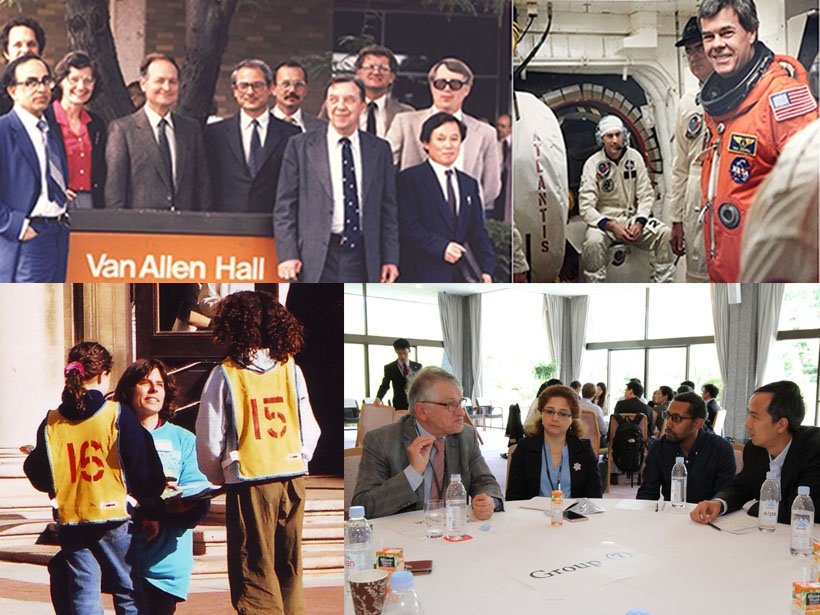AGU journals and books have captured research in Earth and space science for over a century, providing a documented record of scientific discovery. There is another history, however, which how not been as well documented, and these are the stories of how that scientific research was accomplished. These are the stories that might be told in a department coffee room or recounted after-hours at a scientific meeting, often passed down informally from one generation of scientists to the next.
Perspectives is a collection reflecting on important scientific discoveries, advances, and events in Earth and space science, focusing on the process of scientific discovery.
AGU launched a new journal, Perspectives of Earth and Space Scientists, to capture these stories. Perspectives is a collection of memoirs, essays, and insights by AGU Fellows and other invited authors reflecting on important scientific discoveries, advances, and events in Earth and space science, focusing on the process of scientific discovery. All articles are open access and are intended to be read and understood by the wider geosciences community and the science-interested public, both as a documentation of the past history of our fields and as inspiration for future scientists.
Scientific journals tend to record the what of the research and often skip over the why or how of the research, but these are often the most important aspects for young scientists. These stories address how challenges were met, how obstacles were overcome, and how funding was obtained. Research papers tend to avoid an author’s personality, except obliquely, but Perspectives stories revel in the personalities, revealing how deals were made, alliances forged, and sometimes how conflicts were resolved. This is often what young scientists want and need to know to succeed in their research.
Although Perspectives articles do not focus solely on the scientific research, they are still very clearly scientific articles, and as such they cite past research, contain reference lists, are peer-reviewed, and are themselves citable publications.
Perspectives articles contain a balance of both scientific and personal history, blended in an engaging story.
Because Perspectives articles contain a balance of both scientific and personal history, blended in an engaging story, authors often find these articles to be more difficult to write than a more traditional paper. As we have all encountered, good storytelling is a challenging art form, often mastered only after years of practice. It is therefore not unlikely that the paper may go through a few rounds of revisions before its story becomes sufficiently impactful.
I don’t use the word “story” casually. Humans evolved to learn effectively through the telling of stories, as cultural memory was passed down with societies through storytelling for thousands of years before the written word was invented. Within the most recent pedagogical advances in science education, as exemplified by the phenomenon-based learning of the K-12 Next Generation Science Standards, student understanding is best attained when the science is structured around engaging storylines that address relevant and observable phenomena.
In the context of Perspectives, a good story is not a biography or Wikipedia entry or prosaic retelling of one’s CV. A story needs a thesis, a plotline, and usually some degree of character development (i.e., of the author). This story should be truthful and fair and have a takeaway message that can be of use to future scientists. Beyond that, however, there many different approaches that an author can take. How were you drawn to your chosen field? Were there critical events or turning points in your career? What obstacles did you overcome? How did a particular research field or scientific program evolve? What are some highlights and reflections on the current status of your field and where do you think it is going? Some degree of humor is often welcome but not required. Humility is always a necessity. The articles published thus far span a wide range of formats.
We seek submissions from a broad diversity of author identities, backgrounds, and career pathways.
The first round of Perspectives articles were solicited from AGU Fellows, but we now seek further submissions from a broad diversity of author identities, backgrounds, and career pathways, to capture the full diversity of current AGU membership that may inspire researchers from diverse backgrounds.
Articles are published by invitation only but we welcome proposals. If you feel that you have a personal scientific story to document and disseminate, please send an article proposal for consideration by the Editorial Board. There are no charges for publishing articles in Perspectives and all articles are published with an open access license.
—Michael Wysession ([email protected]; ![]() 0000-0003-4711-3443), Editor in Chief, Perspectives of Earth and Space Science, and Department of Earth and Planetary Sciences, Washington University in St. Louis
0000-0003-4711-3443), Editor in Chief, Perspectives of Earth and Space Science, and Department of Earth and Planetary Sciences, Washington University in St. Louis
Citation:
Wysession, M. E. (2021), Telling the stories behind the science, Eos, 102, https://doi.org/10.1029/2021EO162169. Published on 02 September 2021.
Text © 2021. The authors. CC BY-NC-ND 3.0
Except where otherwise noted, images are subject to copyright. Any reuse without express permission from the copyright owner is prohibited.

